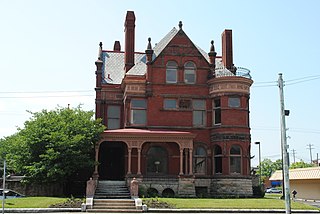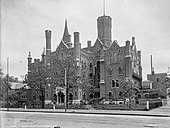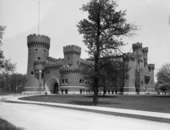The Near East Side is a neighborhood located near downtown Columbus, Ohio, made up of several neighborhoods: Mount Vernon, King-Lincoln Bronzeville, Eastgate, Franklin Park, Nelson Park, Olde Towne East, and Woodland Park.

Downtown Columbus is the central business district of Columbus, Ohio. Downtown is centered on the intersection of Broad and High Streets, and encompasses all of the area inside the Inner Belt. Downtown is home to most of the tallest buildings in Columbus.

Olde Towne East is a neighborhood located in the historical Near East Side of Columbus, Ohio and is one of Columbus' oldest neighborhoods. The area has over 1,000 homes, some as old as the 1830s, and more than 50 architectural styles as a result of its history. These homes were built by many of the famous individuals of Columbus including industrialists, lawyers, judges, teachers, architects, mayors, governors, and legislators, many of whom shaped the city.
Columbus, the state capital and Ohio's largest city, has numerous neighborhoods within its city limits. Neighborhood names and boundaries are not officially defined. They may vary or change from time to time due to demographic and economic variables.

Driving Park is an urban residential area on the Near East Side of Columbus, Ohio just south of Interstate 70. Mainly a middle-class, predominantly African American neighborhood, Driving Park and its surrounding neighborhoods consist of an area of 17,730 residents. Driving Park received its name from its historic past as a large racing complex, first for horses and later for automobiles.

Old Oaks Historic District, or Old Oaks, is a neighborhood just south and east of downtown Columbus, Ohio and is an example of a streetcar suburb in the city.

The Columbus Foundation is a nonprofit charitable organization in Columbus, Ohio, founded in 1943.

Woodland Park is a residential neighborhood located in the Near East Side of Columbus, Ohio that houses approximately 1,500 residents. The neighborhood was previously home to such figures as artist Emerson Burkhart, cartoonist Billy Ireland, and judge William Brooks. Established in the early 20th century, Woodland Park has grown from its planned neighborhood roots into a neighborhood that contains various faith communities, schools, sources of entertainment and recreation, and borders an extension of the Ohio State University medical center.

Franklin Park is a neighborhood located on the Near East Side of Columbus, Ohio. Both the historic neighborhood and landmark, the Franklin Park Conservatory and Botanical Gardens, are named after the 88-acre park.

The W. H. Jones Mansion was built in 1889 at 731 East Broad Street, Columbus, Ohio as the residence of dry goods store owner William H. Jones and his wife Josephine. The original cost to build it was $11,250. He lived there until 1923. Jones modelled the house after another mansion in Barnesville, Ohio. The Olde Towne East Neighborhood Association successfully prevented it from being demolished to make way for a Long John Silver's restaurant. The home is an example of Queen Anne style architecture, with a corner turret, third story ballroom and a carriage house in the rear. Its foundation is high ashlar stone, its roof is slate, and the main body of the building is made of red pressed brick.

The Christopher Inn was a hotel in Downtown Columbus, Ohio. The cylindrical mid-century modern hotel had 16 floors, 137 wedge-shaped rooms, and modern interiors at the time. It was built on the site of the Alfred Kelley mansion, which was disassembled in order to build the hotel. The Christopher Inn operated from 1963 to 1988, when it was demolished. The site is now occupied by an 11-story office building constructed in 2001.
S.G. Loewendick & Sons, also known as Loewendick Demolition Contractors, is a demolition company based in Grove City, Ohio, a suburb of Columbus. The company is the largest specializing in demolition in Central Ohio. It has torn down most of the landmark buildings in Columbus in recent decades, including Union Station, the Ohio Penitentiary, the Christopher Inn, the Deshler Hotel, and the Ohio State University Drake Performance and Event Center.

Capitol Square is a public square in Downtown Columbus, Ohio. The square includes the Ohio Statehouse, its 10-acre (4.0 ha) Capitol Grounds, as well as the buildings and features surrounding the square. The Capitol Grounds are surrounded to the north and west by Broad and High Streets. These are the main thoroughfares of the city since its founding. They form the city's 100 percent corner. The grounds are surrounded by 3rd Street to the east and State Street to the south. The oldest building on Capitol Square, the Ohio Statehouse, is the center of the state government and roughly in the geographic center of Capitol Square, Columbus and Ohio.

Columbus Public Health is the health department of Columbus, Ohio. The department is accredited by the Public Health Accreditation Board. The department dates to 1833, when the city's mayor appointed five citizens to help with its cholera outbreak. It became a permanent body to activate whenever health emergencies arose.

Broad Street is a major thoroughfare in Central Ohio, predominantly in Franklin County and Columbus. It stretches east from West Jefferson at Little Darby Creek to Pataskala. The street is considered one of Columbus's two main roads, along with High Street.

The Columbus Landmarks Foundation, known as Columbus Landmarks, is a nonprofit historic preservation organization in Columbus, Ohio. The foundation is best-known for its list of endangered sites in the city and its annual design award, given to buildings, landscapes, and other sites created or renovated in Columbus. It was established in 1977 as a project of the Junior League of Columbus, Ohio, following the demolition of the city's historic Union Station. It is headquartered at 57 Jefferson Avenue, a contributing structure in the Jefferson Avenue Historic District in Downtown Columbus.

Elah Terrell (1851–1920) was an American architect from Columbus, Ohio. Terrell designed important buildings under the company Elah T. Terrell & Co. in Ohio, notably in Sheffield, Lorain County, and Columbus. Terrell was a member of the Ohio chapter of the American Institute of Architects.

The Joseph F. Firestone House was a historic house at 1266 E. Broad Street in Columbus, Ohio. The building contributed to the East Broad Street Historic District, on the National Register of Historic Places. It was demolished by the Columbus Foundation in 2008.

The Hartman Building and Theater was a pair of historic buildings on Capitol Square in Downtown Columbus, Ohio. The structures were commissioned by Samuel B. Hartman, designed by Richards, McCarty and Bulford in the Renaissance Revival style. The theater was demolished in 1971, followed by the office building in 1981.

The Clinton DeWeese Firestone mansion was a historic house on East Broad Street in modern-day Downtown Columbus, Ohio.





























